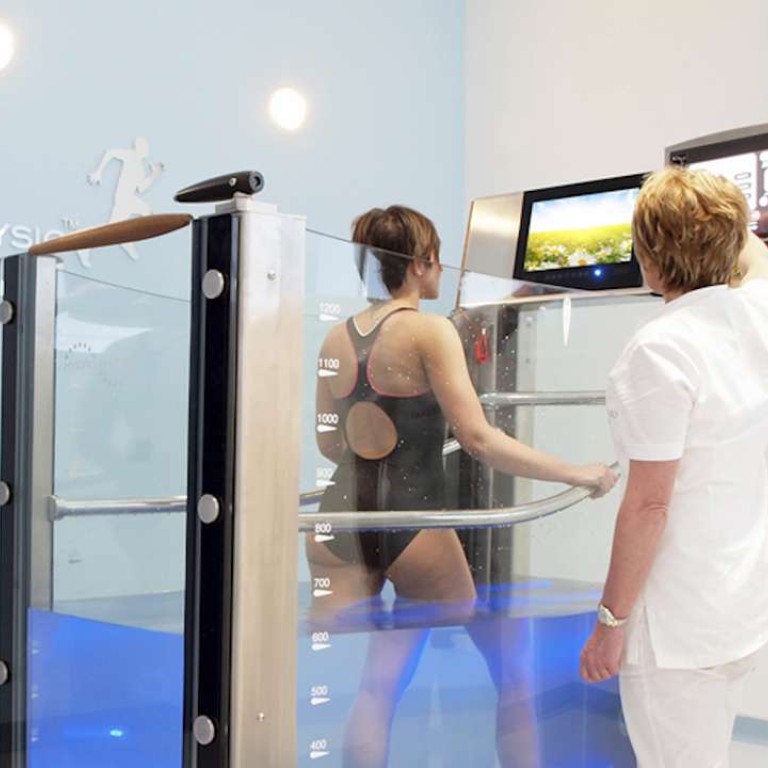
Five new kinds of treadmill, including one on wheels, and how to work out on them
From high-intensity training on a user-powered treadmill at a gym in Central, Hong Kong, to treading in water, while you work, or on the road, your daily jogging routine will never be the same
Running on the treadmill may seem boring, but classes are popping up to try to spruce things up a bit. They involve a mix of interval training on a treadmill with strength training, and have grown in popularity in the US and Britain recently. In Hong Kong, a new indoor boot camp facility in Central, HIT45, began offering a 45-minute high-intensity class when it opened on Stanley Street in June.
What makes the HIT45 class extra tough is its unusual curved treadmill that generates its own electrical power through the user running on the belt. The power consumption of this environmentally friendly treadmill is said to be as low as 40 watts, compared to the 1,500 watts of a conventional treadmill.

I can vouch that the GreenJog treadmill definitely works your heart and legs harder, having recently gone for a trial class at HIT45 led by celebrity trainer Carmela Mondello, who flew in from Los Angeles (where she leads a similar class at the home of treadmill workouts, Barry’s Bootcamp). You need to claw the ground to get the belt moving, which really works the hamstrings, calves and butt much harder. Fortunately the total time spent on the treadmill is not long – three- to four six-minute bouts that include a few 15-second sprints, some jogging and some walking.
When it comes to fitness equipment, trends come and go, but the treadmill has been a bread and butter machine of gyms since the 1960s. Its popularity – especially the fact that many people pay to run on a treadmill – is ironic, given the machine was created as a punishment device in 1818.
English civil engineer William Cubitt invented the “treadwheel” to reform convicts. Prisoners were forced to climb the spokes of a large paddle wheel to create energy to pump water or crush grain (hence, the name change to “treadmill”).
With such a history, it’s perhaps fitting that many still consider it as a form of punishment. But we’re gluttons for it, aren’t we? Here’s a look at some new different ways to workout on a treadmill.

Curved treadmill
What: a non-motorised manual treadmill with a U-shaped tread that is powered by the user and has no speed setting. Said to burn 30 per cent more calories than running on a conventional treadmill and has 80 per cent less impact on the runner’s joints.

Anti-gravity treadmill
What: inspired by an invention by a Nasa biomechanics researcher in the 1990s, this treadmill reduces the impact of gravity on your joints by selecting a weight between 20 to 100 per cent of your body weight by 1 per cent increments. It works by lifting you off the surface of the treadmill according to your desired weight. Main use has been in physiotherapy (PT) clinics, rehabilitation facilities and wellness centres for patients looking to regain mobility, develop strength and fitness, and increase range of motion and natural movement – all while minimising stress on injuries.

Underwater treadmill
What: this machine semi-submerges runners in water, decreasing the stress on joints yet provides strength training resistance for a workout that’s as good as running on land. This lower-impact workout is a good idea for injury rehabilitation. Standing in waist-height water is said to reduce body weight by about 50 per cent and chest-height water by nearly 75 per cent.

Treadmill bike
What: Dutchman Bruin Bergmeester invented this contraption to take away the boredom of treadmill running indoors. The Lopifit is a treadmill on wheels, coupled with an electric assist and gears that allow you to walk four times faster than if you were walking on the ground. So if you ran, you’d be as fast as a bicycle. (One wonders why didn’t Bergmeester just run outside? A question for another day.)

Treadmill desk
What: workout while you work – we’re all familiar with the treadmill desk by now, based on the premise that too much sitting is as bad for heart health as smoking and drinking. You just probably need some good multitasking ability to coordinate steps and serious work.

